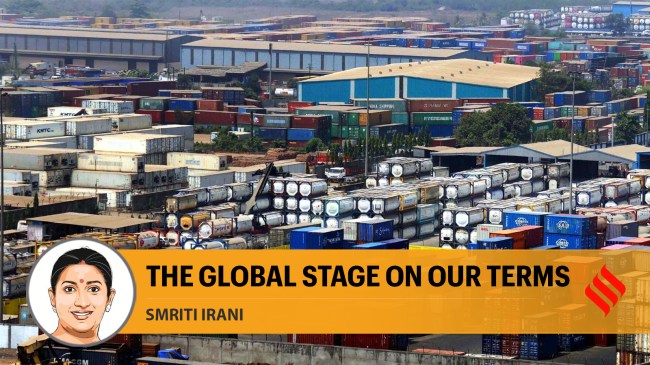Opinion Pact with European Free Trade Association: The global stage, on our terms
The agreement reinforces India’s image as a trusted partner. It is also a vote of confidence for Atmanirbhar Bharat and Make in India
 One of the most immediate benefits from TEPA will be enhanced market access for Indian goods and services.
One of the most immediate benefits from TEPA will be enhanced market access for Indian goods and services. The recent signing of the Trade and Economic Partnership Agreement (TEPA) between India and the European Free Trade Association (EFTA) — its comprises Switzerland, Norway, Iceland, and Liechtenstein — has rightly been hailed as a landmark. It is India’s first comprehensive trade agreement with a grouping of developed European economies.
The pledge to promote investment of about $100 billion over 15 years in India and facilitate up to 1 million direct jobs is an unprecedented commitment in a free trade agreement.
TEPA is not just a trade pact, but a strategic statement symbolising India’s transformation into a globally integrated, confident nation that places its own priorities at the centre of global cooperation. It shows that India can negotiate on equal terms with advanced economies, securing commitments that prioritise its long-term interests. It reinforces India’s image as a trusted partner and also a vote of confidence in India’s vision of an Atmanirbhar Bharat and its Make in India strategy.
One of the most immediate benefits from TEPA will be enhanced market access for Indian goods and services. EFTA countries have agreed to eliminate or reduce tariffs on 92.2 per cent of tariff lines, representing 99.6 per cent of India’s exports by value and to provide duty-free treatment for all non-agricultural products. For Indian exporters of organic chemicals, textiles, gems and jewellery, and industrial products, this is a new opportunity. For consumers, it promises competitive prices and more choices.
India has secured commitments across 128 sub-sectors from Switzerland, 114 from Norway, 110 from Iceland, and 107 from Liechtenstein. These commitments would benefit India’s information technology professionals, business service providers, and skilled workforce, reinforcing India’s role as a leading services hub of the world.
However, far beyond the tariff concessions and enhanced market access, TEPA’s power lies in enabling strategic and technological collaborations for India, thereby providing access to the wider European market. More importantly, EFTA’s advanced capabilities in precision engineering, pharmaceuticals, health sciences, renewable energy, and frontier technologies align with India’s needs. With its skilled talent pool, India can not only absorb these technologies but also adapt, scale, and innovate them to meet the demands of its domestic market and beyond.
This synergy comes at a critical moment. India’s pledge to achieve Net Zero by 2070 demands a complete reimagining of its energy ecosystem. The target of installing 500 GW of renewable energy capacity by 2030 is ambitious but achievable, provided partnerships are forged to access finance, research, and innovation at scale. TEPA will help by opening avenues for European green finance, technology partnerships, and capital earmarked for sustainability. For a country balancing the twin challenges of economic development and climate action, this infusion of trust and resources could not be timelier.
India’s clean energy march is already impressive. As of July 2025, the country has achieved a total non-fossil fuel energy capacity of nearly 243 GW, including 116 GW of solar, 52 GW of wind, and nearly 50 GW of hydroelectric power. This is 50 per cent of its installed electricity capacity from non-fossil fuel sources, five years ahead of the target under Nationally Determined Contributions to the Paris Agreement. Along with hydro, geothermal energy is finding fresh attention, and green hydrogen is being positioned as the fuel of the future. Yet, the challenge remains of ensuring a stable baseload power source to complement the renewables which work intermittently. This is where nuclear energy presents a compelling solution. Here lies one of India’s most significant untapped advantages, its thorium reserves. India holds nearly a quarter of the world’s thorium, a fuel that is clean, safe, and abundant. Unlike uranium, thorium does not pose the same risks of proliferation and fits squarely into our future energy security vision.
India’s three-stage nuclear programme has long envisioned thorium as its eventual goal, but scaling it up has remained a challenge. This is where TEPA may play a key role and serve as a catalyst.
With the EU’s Sustainable Finance Taxonomy classifying certain nuclear activities as aligned to its objectives, India can potentially tap into European funds earmarked for green transitions to support pilot thorium projects. Collaborative research with partners like Norway, which has led in thorium fuel irradiation testing and has a specialised research ecosystem, can accelerate the research and practical rollout of thorium in India’s energy mix. By developing thorium energy, India would, in time, secure more stable baseload power and export technology, expertise, and even reactor designs to other nations.
TEPA is, therefore, a template for how India will engage with the world in the years ahead —confidently, strategically, and with a sharp eye on aligning partnerships with domestic aspirations. The tariff cuts and market access will bring immediate relief to exporters and service providers. The binding investment commitments will channel capital into industries that create jobs and expand capacity. The technology transfers and strategic collaborations will strengthen India’s march toward Net Zero, while also supporting ongoing nuclear-energy-related innovation.
In an era where trade is increasingly tied to resilience, supply chain diversification, and climate commitments, TEPA is both an economic and diplomatic asset. It is proof that India’s economic diplomacy is now assertive, visionary, and aligned with the imperatives of a Viksit Bharat. By harnessing the strengths of its partners and combining them with the talent of its people, India is setting the stage for an energy-secure, innovation-driven, and climate-resilient future. The road ahead is long, but with TEPA, India has set a new benchmark for what future global partnerships must aspire to achieve.
The writer is a former Union Minister





